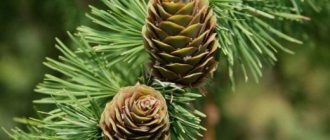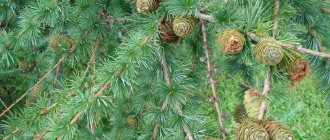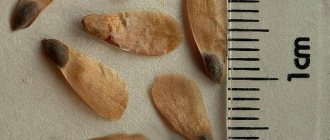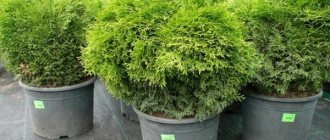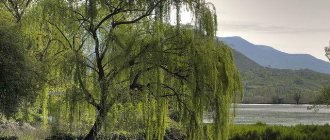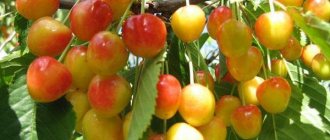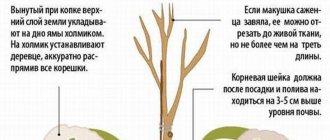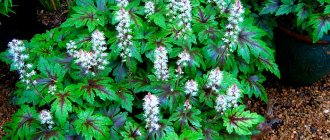Larch has been used by humans as a building and finishing material for a long time. The main reason for this choice is its exceptional strength. In addition, it is quite elastic, moisture-resistant, environmentally friendly, fireproof, can withstand very low temperatures and is resistant to rotting and fungal formations. An example of the reliability of products made from this wood are the piles on which Venice has been located for a very long time.
A curious representative of evergreen flora
Favorable conditions in which this plant of the pine family develops can contribute to its growth to forty meters or more. Its lifespan varies from three hundred to six hundred years, but there are known cases of these trees being eight hundred years old.
The initially existing cone-shaped crown becomes wide and spreading in old age. The small green or reddish-pink cones that ripen in spring can be round or ovoid in shape. When looking at a photo of larch, you can see its striking similarity to pine.
But the main property that distinguishes it from all other conifers is the shedding of needles for the winter. With the onset of spring, light green needles from one and a half to four centimeters long appear on the branches, which turn yellow by autumn. The color of the bark depends on the type of tree, which can be dark or light.
Larch: botanical description of the plant
So, we found out that larch is a coniferous tree. We will consider the features of this plant, as well as its distribution throughout the Earth, below.
The average height of this tree is no more than 50 meters (with a trunk diameter of no more than 1 meter). Larches live on average up to 300 years, although individual specimens have been recorded that have lived up to 800 years.
The peculiarity of this plant is its conical (like many conifers), but very loose (translucent) crown. In places where the wind rose is unidirectional, the crown may have a flag-like shape.
The main feature of this coniferous species is its needles. It is annual and very soft, like for a coniferous tree. Touching larch needles is quite pleasant. Every autumn the tree sheds its needles, and in the spring new, fresh, green needles grow on its branches.
Larches have a fairly developed and powerful root system, which allows them to settle on steep mountain slopes, where strong winds blow throughout the year. In some cases, for greater stability, even its lower branches are rooted in the ground.
Larch is a very light-loving tree, so it chooses appropriate areas for itself: open and unshaded. If the growing conditions are favorable, then the plant is capable of reaching towards the sun at an amazing speed: up to one meter per year!
Larch is very resistant to low air temperatures. It is not afraid of sharp frosts either. This tree is also undemanding to soils. Thus, larch can grow both on the dry soil of a mountain slope and on the waterlogged soil of a swampy lowland. However, if the soil conditions are too unfavorable, the tree will grow very stunted and short.
Scope of application
The wood material of this coniferous representative can be used in many cases. Furniture, parquet, and decorative interior elements are made from raw materials of the first grade, while roofs and supporting structures are made from lower grades.
Proper finishing of wood will prepare it for flooring, roofs, fences, facade decorations, external cladding of buildings, and foundations for interior partitions. The resistance of dry boards to moisture and high temperatures and the preservation of all properties allows for interior finishing of baths.
The sun and precipitation do not destroy the ground coverings of this plant outside buildings, so its use on balconies, terraces, paths and gazebos is the best choice.
How to grow larch in the garden
When planting and caring for larches, do not forget that these are “freedom-loving” plants. Only in an open place do they acquire the characteristic spreading shape of the crown. In shaded places and in dense plantings they are of little decorative value.
Larches are undemanding when it comes to soil; both sand and clay can be used for maintenance when growing trees, but these crops still give preference to light, fertile, slightly acidic loams.
Adult specimens have a powerful, branched root system and do not need feeding. Young plants can be fertilized in the spring after the snow melts on wet soil with complex or combined mineral fertilizer, but in no case with fresh manure and feces.
When caring for larches, replanting should be carried out either in early spring before buds open, or in autumn after the leaves turn yellow. In this case, it is possible to deepen the root collar, although it is not advisable. Plants with actively growing shoots require pruning, take root poorly and take a long time to get sick, so replanting them is not recommended.
Young larches easily tolerate replanting; large ones can be replanted only after preliminary preparation, when a dense lump is formed as a result of repeated pruning of the roots. If the plant is planned to be replanted in the fall, then pruning is carried out in the spring; for replanting in the spring, the plant is prepared in the summer of the previous year. In the process of caring for transplanted larches, you need to follow the same rules as when growing other conifers - water abundantly, and when replanting in spring, you also need to spray until the tree takes root.
Mature larches are extremely drought-resistant. Young plants require sufficient watering during the period of active growth and are able to tolerate the proximity of groundwater, but for adult plants, waterlogging is detrimental.
Most species are highly frost-resistant. Young summer shoots often suffer from late frosts, but grow back easily.
The next section of the article is devoted to how to propagate larch on a personal plot.
To avoid deception
In order not to be deceived when purchasing wood, you need to know what larch looks like. You can distinguish it from the pine offered by unscrupulous sellers by knowing a few simple rules:
- its knots, unlike pine ones (elongated oval, located at an angle to each other), are exclusively round;
- cut rings are brighter and thinner.
Also, in order for the quality of the product to be preserved for a long time, the raw materials should not even show signs of mold, the presence of a bug, or rot.
In order to get a good larch board when purchasing, it is advisable to contact proven and proven companies in the market, where an experienced specialist will help with its selection.
The main things you should pay attention to yourself are:
- standard dimensions: thickness – 20 mm, for floor – 30 mm; width – 60-120 mm;
- minimum of knots - no more than one per 17 cm;
- no cracks or holes;
- indication of the variety on the board or packaging.
In addition, the product must not be warped, damp, or have minimal or no resin pockets. No cracks or gaps are allowed between several boards located in contact. The size of side cracks on the edge should not exceed 40 mm.
The choice of board length is determined by the direction of its use and varies from five hundred to three thousand millimeters. But the best range is from one to two meters.
The color of dry larch can be distinguished from its family relative: depending on the type of tree, it varies from red-yellow with a slightly olive tint to reddish-brown.
The following will help you avoid running into defects, a substituted variety, or fraud when calculating the price:
- familiarization of the buyer with the Sorting Standards, which he has the right to demand from the seller;
- personal inspection of the goods;
- visit to production;
- independent calculation of the area of the material.
Coniferous trees: names
Some will be surprised to learn that the needle (the same “needle”) is a leaf, simply modified. Let us note the main types of coniferous trees:
- Larch
- Thuja (western, eastern)
- Scots pine
- Fir
- Spruce (gray, European)
- Cedar
- Yew
- Juniper
Spruce (evergreen tree): trunk diameter reaches 1.5 m, height – up to 40 m, life expectancy – up to 500 (less often up to 600) years.
Needles: length – up to 3 cm, width – up to 1.5 mm. Norway spruce grows in Siberia, central and northern Europe.
Categorization
The main criterion for determining the types of larch boards is the number and quality of existing knots. For example, “Extra” is a first-class material with an absolutely smooth surface that is free of any defects. “Prima” implies the presence of one knot on one product. In grades A, B, BC and C, their number varies from one or two per meter of length to an unlimited number.
Geographical distribution of the plant
Larch is one of the most common tree species on the planet, numbering up to 15 different species. Very often these trees form vast and light forests. Vast areas are occupied by larch forests in Siberia, as well as in the Far East.
European larch is often called a long-lived tree. She easily lives to be several hundred years old. In Russia, three types of larch are most often found: Russian, Siberian and Daurian. The latter can be easily distinguished by its shiny silvery buds. In Transbaikalia, entire forests of Daurian larch grow.
Western and American larch have become widespread in North America. In the USA, wood of these species is actively used in construction and industry.
Some imperfections of a good tree
The large amount of resins contained makes the processing of larch timber very expensive. Very high density and humidity prevent good drying and cause difficulties during transportation. This affects the cost of wood and makes it one of the most expensive.
In addition, becoming even stronger over time, it can cause some difficulties with additional finishing during repair work.
But, despite the few disadvantages of larch, the advantages make it a building material that will only get better over time. Its quality, provided all the rules are followed, from processing to installation, will not change, and will serve for many years to those who have chosen in its favor.
Let's talk about the benefits
Larch is widely used in construction. In terms of hardness, it belongs to the middle group, comparable to oak. It has good resistance to impacts and chips, so good and high-quality parquet is made from it.
Water resistance allows use in exterior finishing, in rooms with high moisture. By absorbing water, the material becomes even stronger. Therefore, since ancient times, this type has been used in the construction of bridges, in shipbuilding, and in all places close to water.
Floorboards made from this species will last a long time due to its wear resistance and moisture resistance. Floorboards made from this wood are widely used in open spaces, terraces, verandas, and gazebos. Previously, these boards undergo special treatment, they are coated with a solution to form a protective film, so that the flooring does not fade in the sun, and the pores do not become clogged with dirt, and also maintains its aesthetic appearance and quality for many years. Abroad, this breed is popular in the construction of houses, used in finishing work, and in the manufacture of high-quality furniture.
Photo of larch
Reproduction
The main method of larch propagation is by sowing seeds. They can be taken from cones collected from an adult tree or bought in a store. Sow seeds, mixing them with sand, in prepared boxes; do this in winter.
Bright and charming autumn larch
Sprinkle the seeds thicker, they do not germinate well, and only with abundant sowing is there a chance of getting several successfully germinated future seedlings. In spring, the boxes should be taken to a sunny place and young plants should be watered regularly. Seedlings that have become stronger and have reached two years of age can be transferred to open ground.
Larch is transplanted into open ground at the age of two years.
Grafting cuttings of larch is problematic. As a rule, they do not take root well, but designers and gardeners take risks using this propagation method for special types of trees. The method is not suitable for open ground, but gives certain results in special nurseries.
Medicinal components of the plant
As already mentioned, larch is highly valued in folk and traditional medicine due to its medicinal properties. Doctors especially highlight such beneficial properties of the plant as:
- neutralization of harmful microbes and bacteria;
- elimination of foci of inflammation;
- accelerating the processes of blood clotting and wound healing;
- relieving pain and symptoms of poisoning;
- strengthening blood vessels;
- stabilization of metabolic processes.
Almost all parts of the tree are used for treatment: bark, needles, cones, resin, chaga and buds.
Needles
Larch needles are used to prepare various infusions and decoctions, which are excellent for colds and coughs, bleeding gums, scurvy, toothache, and also, if necessary, boost immunity. An excellent result is ensured due to the increased content of vitamin C in the needles. Also, needles are an important component of fortified drinks and dietary salads, as they are not only healthy, but also have excellent taste.
Bark
Larch bark has proven itself excellently as a medicine for the treatment and prevention of heart failure, prostatitis, cysts of various etiologies, skin cancer and diseases of the oral cavity. The reason for the high effectiveness of the bark is that it is an excellent source of pectin and other equally useful substances, in particular arabinogalactan, which helps strengthen the immune system.
As an external remedy, preparations from larch bark are prescribed to treat abscesses, wounds and ulcers, and special tinctures will help get rid of hernias, intestinal infections, diarrhea and stabilize the menstrual cycle.
Cones
Larch cones often become an important component of folk medicines used to treat coughs, colds, as well as nervous and heart diseases. Interestingly, tasty and healthy honey is also prepared from the cones, which is rightfully considered an excellent remedy for fighting asthma and gastrointestinal diseases. But honey also helps restore strength and get rid of symptoms of mental exhaustion.
Resin (resin)
Resin, also known as resin, is one of the most famous and effective folk remedies. Resin is extracted from natural cracks in the larch bark, from frost holes or artificial cuts. Only hardened resin is removed from the holes, and special attention should be paid to the fact that its maturation can sometimes last several years. The process of isolating useful substances that will later be used as medicine is quite remarkable: the collected resin is boiled, placed in a fabric bag and immersed in a container of water. As a result of this treatment, the resin is melted and then floats to the surface, while not very useful impurities remain in the bags.
Essentially, larch resin consists of rosin and essential oil, so it is often used to quench thirst, improve digestion, cleanse the mouth, and also to treat diseases such as neuralgia, rheumatism, myalgia and gout. Ointments based on larch resin are especially popular; they are used for panaritiums, abscesses and inflammation of the respiratory tract. Larch resin has an impressive effect on the body:
- provides protection against viral diseases;
- strengthens the immune system;
- removes toxins;
- cleanses and strengthens blood vessels;
- stimulates blood circulation;
- improves digestion;
- prevents the development of cancer.
Kidneys
Indispensable for various respiratory diseases, problems with the cardiovascular system, rheumatism, liver and lung damage. Larch buds are most often consumed in the form of decoctions or tinctures, and they also usually act as one of the components of herbal preparations.
Chaga (sponge)
The larch sponge (chaga) is actually a parasitic fungus that often grows on the trunk of a tree. The mushroom is round, with a hard shell, under which whitish pulp is hidden - this is what is used for medicinal purposes. At the same time, the size of the sponge is impressive: its weight can range from 30 to 50 kg, depending on age. It is interesting that only young larch chaga is used to create medicines, since the shell of older specimens is very thick, and the chemical composition of the inside of the mushroom changes for the worse over the years.
The composition of chaga is extremely rich in lipid substances, resins, organic acids and oils - it is due to this that the sponge has found its use as a sleeping pill, as well as a mild sedative. It has excellent anti-inflammatory, antifungal, diuretic, hemostatic and laxative properties. Moreover, chaga is well known as a good remedy for combating excess weight.
Use in landscape design
The northern coniferous beauty has about 20 species. To decorate local areas, breeding specialists have developed numerous decorative varieties.
Larch in the landscape
Guided by simple planting rules, you can root a plant either alone in the middle of the lawn or make it part of a composition in your garden plot. To highlight the beauty of this coniferous tree, various deciduous plants and groups of shrubs are used in the garden. Larch looks good in a rock garden.
The most attractive tree is a standard tree, the branches of which hang down in the form of a cascade. It looks beautiful near lampposts and garden paths. Landscape designers also recommend covering the area near the tree with small pebbles. It is important to remember that this representative of conifers does not like wetlands.
Types and varieties of larch
The name “larch” (Larix) denotes a genus of trees. It was first described in 1754 by botanist Philip Miller. The scientist separated pine larches from pines in the family. Currently, 10–15 species of larches are identified in the scientific literature. But not everyone agrees with this. Some botanists divide the genus into 2 parts: Larix - with short bracts and Multiserialis - with long ones.
1 - branch with needles; 2 - branch with male and female flowers; 3-5 - stamens; 6 - scales, cones; 7 - needles; 8 - section of the cone; 9 - bump; 10-11 - cone scales; 12 - seed. Others believe that we are talking about a simple adaptation of trees to climatic conditions, and there is no need to separate some of them into a separate subgenus, considering it a different variety. Larches are the only deciduous coniferous trees. They reach a height of 20–45 m. And, of course, they lose their needles in the fall, but they do not look like the usual leaves, which is why the genus belongs to the pine family.
Did you know? The exact origin of the word "Larix" for larch is unknown. But there are several versions that the term can mean resin (Galic), rich (Celtic), fatty/fat (Latin).
Botanical description of the genus:
- crown shape: cone-shaped, loose, sun rays pass through it well;
- crown features: if the area is dominated by winds of one direction, then it becomes uneven, one-sided;
- maximum height: 45–50 m;
- trunk diameter: 1 m;
- shoots: dimorphic, long (from 10 to 50 cm), bearing several buds, and short (1–2 mm);
- leaves: needle-shaped, up to 5 cm long, 1 mm in diameter, solitary, arranged spirally on long shoots or in clusters of 20–50 needles on short ones;
- needle texture: soft;
- needle age: one year old;
- cones: straight and small (1–9 cm in height), green, violet or purple in color when young, and brown when ripe;
- bract scales: can be long or short;
- root system: branched, without a visually distinguishable taproot, but with many powerful anchor laterals, which ensure the tree’s wind resistance;
- life expectancy: 300–500 years.
The tree loves bright sunny areas. Resistant to winter frosts. But it can be felled if it grows in moss swamps, that is, where part of the root is not in solid soil, but in an aquatic environment. Larch grows well on loam and sandy loam soils. In terms of external features, all species are similar to each other and the difference is only minor features noticeable to botanists.
Therefore, the name of most of them reflects the region of distribution: Amur, Kamchatka, Primorsky, American, Kuril, Polish, Western, Siberian. Another part of the trees is named after the scientist who discovered or described them: Komarov, Middendorff, Lyubarsky, Lyell, Potanin, Gmelin.
Common (European)
Common larch (Larix decidua) is also called European or deciduous. This species grows in the mountains of Central Europe, in the Alps and Carpathians, with scattered populations on the plains of northern Poland and southern Lithuania. The tree is found in the mountains at an altitude of up to 2400 m above sea level. Please note that it can only be found in well-drained areas and never in waterlogged areas. European larch is very resistant to cold.
Did you know? The territory where larch grows in Russia is equal to 5 France (4 billion hectares).
It can withstand winter cold down to –50°C. Cultivated as an ornamental tree for planting in gardens and parks. Its strong and durable wood is valued in yacht construction. European larch can be used to make thin, flexible but durable strips for various purposes. The European type of larch can be called the most diverse.
Among the cultivars obtained on its basis are:
- columnar trees with branches directed vertically upward (fastigiata);
- plants with drooping branches and a top that is divided into several others (pendulina);
- multi-stemmed (multicaulis);
- compact or dwarf (short) forms;
- creeping shrubs.
There are even those that have one trunk, but it is somewhat twisted, and then they say that the plant has an indeterminate shape. In total, more than 30 varieties have been created based on European larch.
Did you know? The Puli variety was developed in the 1990s in Hungary by Zsosa Miklos. And he named it after his dog.
Here are some of them:
- Horstmann Recurved is a very interesting tree with a fabulous shape. It is single-barreled, but the barrel can be bent. The branches extending from it are uneven in length and massiveness, bifurcating at the ends, so the crown can be described as cushion-shaped. Height - 2 m. Another feature is the decorative nature of the needles. In spring it is yellow, and by autumn it turns light brown. The variety was obtained in 2003 by Uwe Horstmann's nursery in Germany.
- Kornik (Kornik) is a dwarf bush one meter tall. It looks like a topiary with a spherical crown on one straight leg.
- Little Bogle (Little Bogle) is a shrub with an uneven crown approaching a pyramid, up to 1.6 m high. It has needles of a rich dark green color, which turn golden before they begin to fall in the fall. The variety was obtained in 1990 by a nursery in Montbulk (Australia).
- Pendula (Pendula) is a weeping larch with hanging needles. Height - 10–30 m. The crown width of an adult tree is at least 5 m. For landscape use, Pendula is grafted onto dwarf trunks to obtain low-growing forms of trees with a weeping crown.
- Pretty Carole is a symmetrical, flattened, spherical European larch with typical bright, light green needles. It turns golden before falling off in the fall. Height - 1 m. The variety was obtained in 1993 from the Lanark variety.
- Repens (Repens) - larch with creeping shoots. The variety was obtained in England in 1825. It is classified as a dwarf variety and grows up to 1.5 m by the age of 10. The annual growth of branches is no more than 15 cm under favorable conditions for development. Considering that this larch grows on a trunk, its height can vary depending on the properties of the rootstock. Most often it is a single-trunk tree with a sphere-shaped crown, but it can also be drooping due to thin, flowing shoots. The variety can withstand winter temperatures down to –40°C. In landscape design it is used to decorate the entrance to a building. It is allowed to grow not only in open ground, but also in pots to decorate verandas, patios, cafe areas and urban recreation areas.
- The Krejci variety is considered one of the most unique. Obtained from a deformed sprout by Ladislav Krejci from Zolakovsky (Czech Republic). This is a slow-growing plant with sparse, branching, irregular clusters of shoots, the size of which grows by 5 cm per year. This unevenness gives the plant a special charm. The height of a mature larch does not exceed 1 m. The tree is perfect for a rock garden or any Japanese-style garden.
- Puli (Puli) is similar in appearance to the Pendula variety with a drooping (weeping) crown. But it has denser branching and a lighter shade of foliage. It is considered one of the fastest growing, because the annual growth of its branches is 30 cm. Puli is a standard tree. It does not take up much space and is very decorative. In November, the curtain of Puli branches begins to turn golden in the sun with bright reflections. And in the spring it again looks like an elongated light green bush. The variety should be grown only in the sun on an area with fertile, loose, sandy loam soil.
Alpine
Alpine larch (Larix lyallii / Alpine larch) was first described in 1863 by Filippo Parlatore. Its synonymous names are French, mountain. The height of the tree is 25 m, the diameter of the trunk is up to 1.2 m. It has an irregular, rare conical crown. The bark of alpine larch is thin, smooth, yellowish-gray when young, becoming furrowed and flaky with age.
Did you know? In the legends of the peoples of the North there is a legend that the gods created the first people from larch. But due to the machinations of evil spirits, it was not the larch people that were revived, but clay figurines, which is why people became so fragile and short-lived.
The branches grow horizontally, sometimes they are drooping, often twisted and unevenly spaced. They remain on the trunk even after they dry. Deciduous needles, growing in bunches of 30 to 40 pieces. Its length is up to 35 mm, thickness is up to 0.6 mm. The seed cones are elliptical in shape and arranged vertically. They will be red when they appear, then turn purple and turn brown with age. This larch is common in Canada and British Columbia. Frost resistance of the tree is down to –34°C.
Primorskaya
Coastal larch (Larix maritima) is a naturally occurring hybrid. It is believed that Kamchatka larch crossed with Gmelin or Kayander. It grows in the Khabarovsk Territory, Primorye and northern Sakhalin. The tree reaches a height of 25 m. The shoots of the plant are reddish in color with a bluish coating. The crown shape is cone-shaped. Primorsky larch is quite frost-resistant (–40°C).
Did you know? Venice is built on larch stilts. Its wood is very dense, is not afraid of water and is not subject to destruction for decades.
Siberian
Siberian larch (Larix sibirica) was first described in 1833 by Karl Friedrich von Ledebur. It is also called Russian larch. This is a tree reaching a height of 50 m, with a trunk diameter of 1 m. Its crown is conical in youth, but over time it becomes ovoid. The main branches are at the same level as the lateral ones. Distributed throughout Siberia and the Urals. It is found alone and in groups, is part of mixed forests, but almost does not form separate forest areas. Widely used to produce quality wood that is resistant to rot. In Oregon (USA), the Iseli nursery has produced the only variety of Siberian larch to date - Conica. This happened in 1990. This is a fast-growing tree with horizontal branches. It is resistant to frost and other adverse factors. By the age of 10, Konika grows up to 3 m in height and 1.2 m in width. Its annual growth is 30 cm.
Video: Siberian larch
Japanese (Kaempfer)
Japanese larch (Larix kaempferi / Japanese larch) was first described in 1856 by Elie-Abel Carriere. The tree acquired the name “Kaempfer” in honor of the botanist who was one of the first to visit Japan. There, the plant is grown everywhere to produce strong and durable wood for construction needs. The height of Japanese larch reaches 40 m. The width of the trunk is 7.5 m. Its trunk is round, straight, with long horizontal branches.
The crown is conical, dense, becomes irregular and more open with age. The bark is smooth, red-brown, and fissured with age. The needles are gray-green. Arranged in a spiral. Diamond-shaped in cross section. Pollen cones are ellipsoidal in shape, yellow-brown in color, with numerous bracts at the base, 6 mm long, with numerous stamens. The seed cones are straight, with short, curved peduncles.
Length - 3 cm, width - 2 cm. When unripe, they are purple, and as they ripen they become orange-brown. In its homeland, this species grows on different types of soils, including volcanic ones. But it never appears in swamps and peat bogs. The frost resistance limit of Japanese larch is –28°C. This species is also represented by several cultivated varieties.
Important! Larch needles are used in folk medicine as a hemostatic agent. And the resin from it is used to treat wounds, gout, arthritis and other diseases of the musculoskeletal system.
In the crown form of cultivars, breeders have attempted to preserve and develop the main varieties of the parent variety:
- haptophera - crown of standard conical shape;
- weeping - with decorative hanging shoots.
There are such varieties of Japanese larch:
- Blue Dwarf is a low bush with a single trunk and a spherical crown. By the age of 10 it will grow only up to 0.5 m. As a rule, it is grown on a trunk, which is why it looks like a tree. Short, strongly branching branches make the crown very dense. The diameter of the spherical crown is 80 cm. The variety was obtained in 1982 in the Jan-Dieter zu Eddeloch nursery (Germany). The plant is photophilous, frost-resistant and decorative. Plant it in fertile soil in a rock garden or use it to decorate the entrance of a building.
- The Blue Rabbit variety - unlike the blue dwarf, is represented by a fast-growing tree of a narrow conical shape and exceptional blue needles. This is probably one of the best varieties with needles of this shade. The height of an adult plant will be 3 m and width - 1.3 m. It was obtained from the Leen Konijn nursery in 1960 in the Netherlands.
- Diana (Diana) - fast growing, with twisted branches. It is in demand by connoisseurs of non-standard forms. The trunk is bent in the direction of the prevailing wind, the branches are longer on the leeward side, unevenly spaced. Being of different lengths, they make each tree unique. In adulthood, the conical shape becomes more rounded. The variety was obtained in 1974 in the nursery of Gerhard Beulier in Germany. He named it after the Greek goddess of the hunt. Diana is grown on a standard. Reaches a height of 2 m. Very light-loving. This is also important for needles. Bright sun rays help its shades to appear as brightly as possible. The variety is recommended for use in the Japanese garden, providing it with fertile and moist soil.
- Jakobsen's Pyramid (Jacobsen's Pyramid) is a cone-shaped, almost vertical larch up to 4 m high. The peculiarity of the tree is that its crown from a distance is similar to a poplar - the same narrow pyramidal. This appearance is achieved by the fact that all branches are directed strictly upward. The variety was obtained in 1985 in Denmark. The plant prefers an area with full sunlight and well-drained soil. It is characterized as a hardy and frost-resistant variety.
- Pendula (Pendula) is one of the most non-standard varieties. Firstly, it is standard, and its height and shape depend in part on the rootstock. Secondly, it takes different forms depending on the conditions in which it grows. If the crown is not pruned, then its hanging branches form a weeping shape, descending almost to the ground. Since they are arranged irregularly and are characterized by different lengths, the shape is described as irregular. The variety is considered one of the oldest, dating back to around the 1800s. It was first described by botanist Ludwig Bessner. The height of the plant reaches 7 m, and the diameter of the crown is 3 m. The color of the needles is green-blue. The plant is characterized as frost-resistant, easily adapting to the climate and adverse natural factors.
American
American larch (Larix laricina) was first described in 1773 by Karl Heinrich Emil Koch. This species is also known by other names: tamarack, eastern, black and red larch. Early settlers in America used its wood as a primary building material and also to build boats. Today, American larch also grows in Europe, including the Baltic states, Belarus, and Ukrainian Polesie.
Important! Newport Beauty
-
one of the most demanding varieties.
He is prone to sudden larch death syndrome. This is a disease in which a tree dies for no apparent reason. And the older it is, the more prone it is to disease. Features of American larch:
- It is called red because of its pinkish bark. If you lift it, there will be a red layer underneath it. Female cones are also red at the beginning of development.
- The needles are needle-shaped, up to 3 cm long, light blue-green in color, turning bright yellow in autumn. It is located spirally on long shoots and in dense clusters.
- The crown is one of the most elegant. It is small-branched, narrow-pyramidal with outstretched branches.
The tree is distributed throughout North America. Very resistant to cold and can withstand temperatures down to -65°C. Can tolerate a wide range of soil conditions, but is more likely to grow in bogs or moist organic soils such as sphagnum moss and peat. It is also found on mineral soils of any structure: from clay to coarse sand. It can also grow on limestone soils.
American larch has fewer varieties than European larch, but it is also sufficient. This is also facilitated by the fact that the plant can be used for reclamation of marshy lands. It is considered one of the main crops that can grow in swamps as pioneer plants, and even in areas with very cold winters.
Learn how to grow larch from seed.
The most famous varieties:
- Blue Sparkler (Blue Sparkler) - bred in 1985 by Dr. Sidney Waxman from the University of Connecticut. In the trading network it is often mistakenly classified as a variety of Japanese larch. The tree is characterized by vertically growing branches, light blue needles, which become gray-blue as they age. Like other varieties, after rain it is capable of holding drops of water in the axils of the leaves, sparkling in the rays of the sun. For this reason, the variety in the USA is often called Blue Sparkler. After 10 years of growth, the height of the plant will reach only 1 m, and its annual growth does not exceed 10 m. Blue Sparkler is very popular among landscape designers.
- Deborah Waxman (Deborah Waxman) - also obtained at the University of Connecticut in 1988. Dr. Waxman named the variety in honor of his daughter. This is a larch with blue-green sparse needles. Its crown is wide-pyramidal and quite fluffy. It is always decorative. In May, pink cones will appear on the larch, and in the fall the needles will take on a copper-gold shade. The tree grows only up to 2 m. The plant is climate resistant and can withstand frosts down to –45°C.
- Newport Beauty is a very slow growing globular shrub. Its branches are extremely densely arranged, making it resemble a spruce. Beauty Newport is characterized by bluish-green needles, small height (up to 30 cm), width (60 cm). The variety was obtained in 1988.
- Postus (Postus) is one of the newest varieties. It was accidentally discovered in Canada and added to the collection of conifers at the Kingsbrae Gardens nursery. The tree is characterized by an amazing, very narrow pyramidal crown with densely spaced branches. Postus grows very quickly - up to 60–90 cm per year. And this is the highest growth rate among larches. It is hardy and can withstand frosts down to –45°C.
- Stubby - looks like a thick mound of branches and needles. It is not very tall - only 30 cm in both height and width. This pillow-like larch grows no more than 2.5–3 cm per year. Stubby's needles are a standard blue-green color. But the variety may be of interest to gardeners due to its low growth.
Comparison
Trees as biological specimens
If you look at the plants from afar, you will notice that the pine crown is denser and more rounded. The larch crown is sparse and has an acute-angled shape. However, with age, a tree can change its shape and acquire a rounded appearance in its upper part.
The needle-like needles of pine are stiffer than the completely non-thorny, flattened needles of larch
In addition, an important difference between larch and pine, which many consider key, is that the former, like its deciduous counterparts, is completely freed from its clothing in the fall. Having shed its needles, the larch becomes like a strange dried spruce
Pine pleases with its lush appearance all year round. Its needles can stay on the branches for up to 5 years, and their alternating changes occur imperceptibly.
Trees differ in the size and color of their cones. In pine they are larger, green at first, and brown when ripe. Larch cones look more elegant, they are not so large, more rounded; when recently born, they have a yellow tint; when mature, they are brown.
If we compare the bark of young trees, then pine has a darker bark. With the growth of coniferous representatives, these differences are erased.
Trees as raw materials for building materials
Let's look at the difference between larch and pine used as lumber.
If we talk about the smell, then pine has a pronounced, resinous smell, which cannot be said about larch. Fresh pine looks very light. Then the wood darkens, and products made from it acquire a yellowish tint. Larch is initially quite dark, gradually the shades thicken towards red-brown.
The wood of both types differs in the severity of its structure. Larch has a more distinct fiber pattern. In addition, the wood of this tree has a large percentage of knotty fragments.
Larch is heavy. The difference in weight can be felt by lifting a board of it and a product of the same size made of pine. The heaviness is due to the high density of larch. Its wood is so strong and dense that a nail passing across the grain leaves no mark on it. If you do the same with pine material, the mark will be noticeable, since pine is softer.
Larch does not catch fire as easily as pine. It will take some time to light a splinter from it, and the fire will spread quite slowly. The pine chips will literally burst into flames in a couple of seconds.
Important advantages of larch are its lower thermal conductivity (buildings made of such wood retain heat better) and greater resistance to the destructive effects of moisture than pine.
Larch is a coniferous or deciduous tree
Larch is very common in our country, as well as throughout the world.
Despite its name, larch is a coniferous tree, but not an evergreen tree. Larch needles (soft to the touch) fall off once a year before winter.
Our tree grows in the Far East and Siberia.
- Larch trunk diameter – up to 1 m,
- height – up to 50 m,
- The duration of growth is more than 400 years (there are larches that are slightly less than 800 years old).
Use of larch
A special dye for hides and fabrics is made from larch bark.
Larch wood has the following qualities:
- durability;
- high strength of the material (only slightly inferior to oak wood).
If it is impossible to hammer a nail into dried larch wood, then removing a nail hammered into the material before it has had time to dry will also not work.
Thanks to these qualities, larch is widely used in both the chemical and construction industries. But this applies mostly to American larch species.
In our country, due to the very high density of most types of larches, processing and use in construction are extremely difficult.
Larch at the dacha
Polish larch and Japanese larch are plant species cultivated in our country.
Japanese larch has been grown in Russia since the end of the 19th century. In Europe, the tree can often be found in parks and gardens. Since the plant is resistant to diseases and pests, it is grown as an ornamental, and in Japan (the plant’s homeland) it is used as a bonsai.
Polish larch, except in the forest, can be observed in botanical gardens and parks (height - 30 m, lifespan exceeds half a century). The tree grows quickly, loves light and is resistant to low temperatures.
In general, it is very difficult to grow larch in the countryside on your own, even more difficult than pine or spruce. The plant survives transplantation with great difficulty. Therefore, seeds are mainly used for propagation.
We recommend reading on this topic: Coniferous trees photos and names for children
Amazing feature
This species has modified leaves - needles. It would seem that at this point the question of which larch tree is coniferous or deciduous is no longer relevant. But Larix's needles are special - very soft, not prickly, pleasant to the touch, growing in bunches of 40-50 pieces or singly. In addition, it is an annual, that is, it falls off every fall, and grows again in the spring - young, bright green. It is this fact that most often raises doubts about whether larch belongs to coniferous or deciduous trees. Since neither spruce, nor pine, nor fir - traditional representatives of conifers - shed their needles for the winter. Everyone knows that the Christmas tree is “the same color in winter and summer.” However, those who are interested in whether larch is a deciduous or coniferous tree should know that it is still a coniferous species belonging to the Pine family.
How to propagate larch: conditions for growing a crop from seeds
The most rational way to propagate larch is by seed. Only freshly collected seeds are suitable, but even among them the germination rate is low. When stored under normal conditions, germination is lost after a year, and sometimes even after 3-4 months, but if they are kept in an airtight container at a temperature of 0 to 5 ° C, then they will sprout after 10 or more years.
Seeds freshly fallen from cones are capable of immediate germination, since their embryo is in a stage of shallow dormancy, but dried and especially stored seeds need to awaken the embryo using stratification.
The most rational methods for sowing crop seeds are:
- Pre-winter sowing. In the autumn, immediately after collection, without drying, the seeds are sown in a ridge to a depth of 3-5 cm and mulched to a height of 1-1.5 cm. In the spring, after the emergence of seedlings, the plants are pricked up or left on the ridge until autumn or next spring.
- Snowmaking. Seeds are sown in boxes in autumn or winter, kept warm for 2-3 weeks and then taken out under the snow until spring. In spring - early summer, after the emergence of seedlings, the plants are planted in a ridge or left in boxes until autumn.
- Cold stratification. At the end of winter, the seeds are sown in boxes or bowls in an earthen mixture consisting of rotted leaf soil, peat and coarse sifted sand in a ratio of 3:1:1. The crops are kept warm for 2-3 weeks, and then stored in a refrigerator or basement at a temperature of +3 to +5 ° C for 1-2 months, maintaining an even, moderate level of substrate humidity and a constant temperature.
Stratified seeds for growing larches are transferred for germination to a bright, warm (+18...+25 °C) place. Seedlings are protected from direct sunlight and watered moderately. If the seeds have sprouted too thickly, then picking is necessary. When it gets warmer, the crops are taken out into the garden, and after hardening, they are planted in a ridge.
When growing larches from seeds, the seedlings are unpretentious and develop quickly.
Creeping forms can be propagated by horizontal cuttings, but rooting rarely occurs in the first year. Cuttings are possible, but they involve great difficulties and are ineffective.
